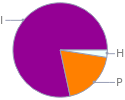Input interpretation

phosphonium iodide | elemental composition
Result

Find the elemental composition for phosphonium iodide in terms of the atom and mass percents: atom percent = N_i/N_atoms × 100% mass percent = (N_im_i)/m × 100% Plan: • Write the chemical formula and gather atomic masses from the periodic table. • Determine values for N_i, m_i, N_atoms and m using these items. • Finally, compute the percents and check the results. Write the chemical formula: PH_4I Use the chemical formula to count the number of atoms, N_i, for each element and find the total number of atoms, N_atoms, per molecule: | number of atoms H (hydrogen) | 4 I (iodine) | 1 P (phosphorus) | 1 N_atoms = 4 + 1 + 1 = 6 Divide each N_i by N_atoms to calculate atom fractions. Then use the property that atom fractions must sum to one to check the work: | number of atoms | atom fraction H (hydrogen) | 4 | 4/6 I (iodine) | 1 | 1/6 P (phosphorus) | 1 | 1/6 Check: 4/6 + 1/6 + 1/6 = 1 Compute atom percents using the atom fractions: | number of atoms | atom percent H (hydrogen) | 4 | 4/6 × 100% = 66.7% I (iodine) | 1 | 1/6 × 100% = 16.7% P (phosphorus) | 1 | 1/6 × 100% = 16.7% Look up the atomic mass, m_i, in unified atomic mass units, u, for each element in the periodic table: | number of atoms | atom percent | atomic mass/u H (hydrogen) | 4 | 66.7% | 1.008 I (iodine) | 1 | 16.7% | 126.90447 P (phosphorus) | 1 | 16.7% | 30.973761998 Multiply N_i by m_i to compute the mass for each element. Then sum those values to compute the molecular mass, m: | number of atoms | atom percent | atomic mass/u | mass/u H (hydrogen) | 4 | 66.7% | 1.008 | 4 × 1.008 = 4.032 I (iodine) | 1 | 16.7% | 126.90447 | 1 × 126.90447 = 126.90447 P (phosphorus) | 1 | 16.7% | 30.973761998 | 1 × 30.973761998 = 30.973761998 m = 4.032 u + 126.90447 u + 30.973761998 u = 161.910231998 u Divide the mass for each element by m to calculate mass fractions. Then use the property that mass fractions must sum to one to check the work: | number of atoms | atom percent | mass fraction H (hydrogen) | 4 | 66.7% | 4.032/161.910231998 I (iodine) | 1 | 16.7% | 126.90447/161.910231998 P (phosphorus) | 1 | 16.7% | 30.973761998/161.910231998 Check: 4.032/161.910231998 + 126.90447/161.910231998 + 30.973761998/161.910231998 = 1 Compute mass percents using the mass fractions: Answer: | | | number of atoms | atom percent | mass percent H (hydrogen) | 4 | 66.7% | 4.032/161.910231998 × 100% = 2.490% I (iodine) | 1 | 16.7% | 126.90447/161.910231998 × 100% = 78.38% P (phosphorus) | 1 | 16.7% | 30.973761998/161.910231998 × 100% = 19.13%
Mass fraction pie chart

Mass fraction pie chart